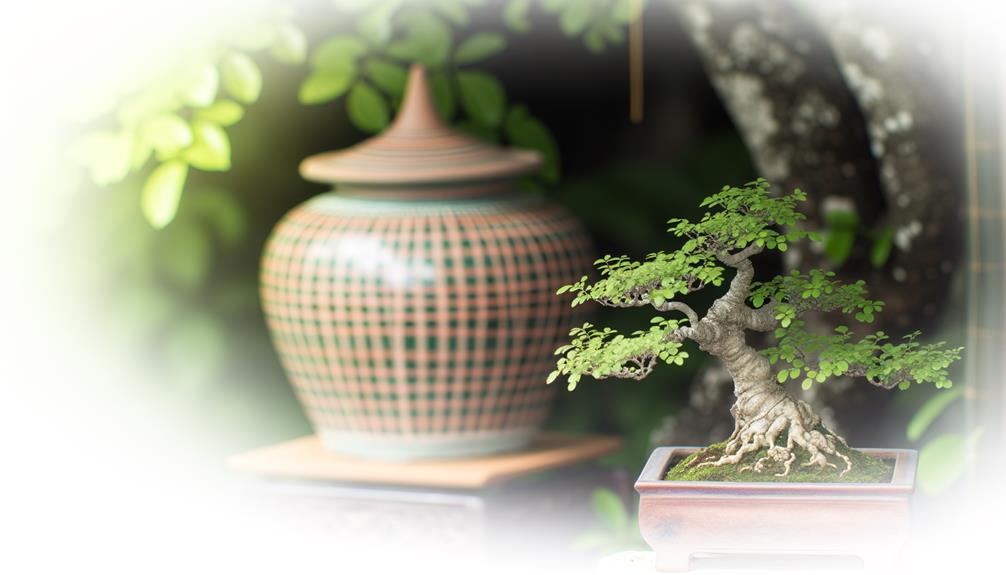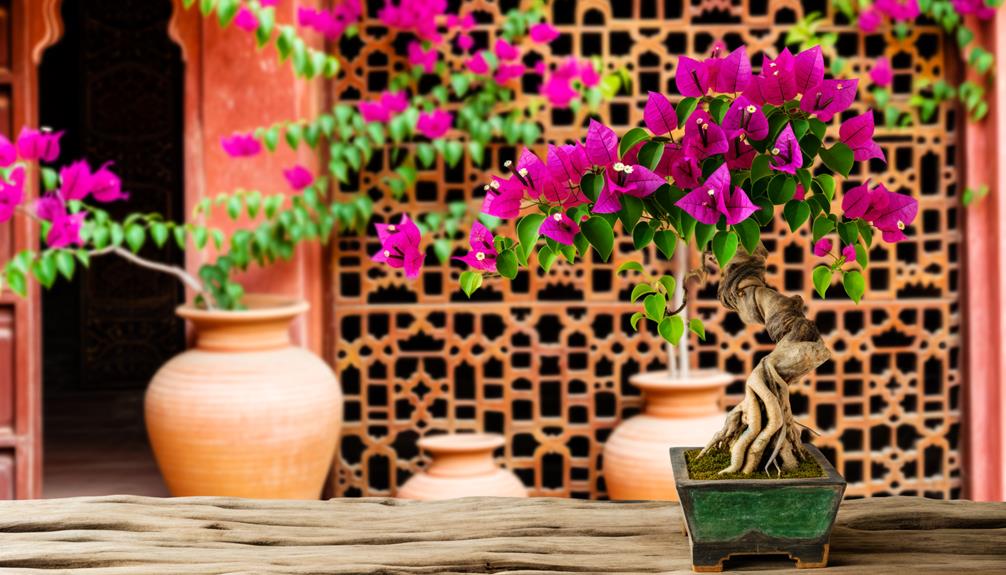Top 3 Best Plants to Make Bonsai in India
India provides an excellent range of suitable plants for bonsai enthusiasts. The Ficus Retusa, known for its glossy, oval leaves and adaptable nature, is highly favored.
The Banyan Tree thrives in warm, humid climates, with essential pruning for its aerial roots. The Indian Elm, with its textured bark, requires well-drained, acidic soil.
The Jade Plant, ideal for succulent lovers, demands regular sunlight and well-draining soil. Bougainvillea is resilient to extensive wiring and pruning, thriving in full sunlight.
The Peepal Tree, revered in Indian culture, offers a vigorous growth habit and strong root system. For a deeper understanding, explore the unique attributes of each.

Key Takeaways
- Ficus Retusa is adaptable to various lighting conditions and recovers quickly from pruning.
- Banyan Tree thrives in warm, humid climates and requires regular pruning for aerial roots.
- Indian Elm has textured bark, lush foliage, and requires well-drained, slightly acidic soil.
- Jade Plant features succulent leaves, needs regular sunlight, and adapts to diverse climates.
- Peepal Tree offers strong roots, vigorous growth, and significant cultural value in Hinduism and Buddhism.
Ficus Retusa

The Ficus Retusa, also known as the Banyan Fig or Ginseng Ficus, is one of the most popular species for bonsai cultivation in India due to its robust adaptability and ease of care. This evergreen tree features glossy, oval leaves and an expansive root system that is highly conducive to bonsai styling.
Its aerial roots, which can be pruned and shaped, allow for creative and intricate designs. Moreover, the Ficus Retusa thrives in various lighting conditions, from full sun to partial shade, making it versatile for indoor and outdoor cultivation. Its tolerance to pruning and ability to recover quickly from trimming enhance its appeal among bonsai enthusiasts.
Regular watering and occasional fertilization guarantee excellent growth and development.
Banyan Tree
The Banyan tree, known scientifically as Ficus benghalensis, thrives in warm, humid climates with ample sunlight, making it ideal for bonsai cultivation in India.
Effective pruning techniques are crucial to control its vigorous growth and to maintain its characteristic aerial roots and dense canopy.
Proper care and meticulous shaping guarantee the Banyan bonsai develops into a miniature yet majestic representation of its natural form.
Ideal Growing Conditions
Banyan trees thrive in well-drained, fertile soil with a pH range of 6.0 to 7.5, coupled with ample sunlight and humidity to support their extensive root systems. Best growth is achieved with at least six hours of direct sunlight daily, which encourages strong foliage and root development.
Humidity levels of 40-60% are ideal, as they prevent desiccation and promote lush growth. Additionally, consistent moisture is essential; however, waterlogging must be avoided to prevent root rot.
Temperature regulation is equally important; banyan trees flourish in a temperature range of 20-30°C. Regular organic fertilization enhances nutrient availability, promoting vigorous growth.
Pruning Techniques
Effective trimming methods are crucial for maintaining the structural integrity and aesthetic appeal of Banyan bonsai trees. Trimming should be carried out during the growing season, primarily in spring and early summer.
Start by eliminating any dead or diseased branches to boost overall tree health. Then, concentrate on thinning out overcrowded areas to improve light penetration and air circulation. Utilize sharp, sterilized trimming shears to make precise cuts, making sure that the cuts are angled to avoid water accumulation.
Regular pinching of new shoots is crucial to manage growth and uphold the desired shape. Furthermore, root trimming should be done biennially to prevent root-bound conditions and promote a strong root system. These careful practices guarantee a well-proportioned and visually attractive Banyan bonsai.
Indian Elm

The Indian Elm (Holoptelea integrifolia) is a popular choice for bonsai enthusiasts in India due to its robust growth and ease of maintenance.
This species is noted for its ability to adapt to various pruning techniques, making it highly desirable for shaping and training.
Additionally, its textured bark and lush foliage contribute greatly to its aesthetic appeal, offering a visually striking miniature tree.
Growth and Maintenance
In cultivating Indian Elm as a bonsai, it is essential to understand the specific growth patterns and maintenance requirements that guarantee its healthy development.
Indian Elm (Ulmus parvifolia) is a deciduous species, favoring well-drained, slightly acidic soil. It thrives in full sun but can tolerate partial shade.
Regular pruning is vital to maintain its compact form and promote ramification. Watering should be moderate; avoid waterlogging as it can lead to root rot.
Fertilize with a balanced, slow-release fertilizer during the growing season. Vigilance against pests like aphids and scale insects is important.
Repotting every two to three years ensures adequate root space, fostering robust growth. Proper care will result in a resilient, aesthetically pleasing bonsai.
Aesthetic Appeal
Characterized by its intricate branching structure and delicate, serrated leaves, the Indian Elm bonsai presents a visually enchanting and harmonious aesthetic that appeals to bonsai enthusiasts and horticulturists alike.
The aesthetic allure of the Indian Elm is multifaceted, combining natural elegance with intricate details:
- Branching Complexity: The fine, interwoven branches create a dynamic silhouette, offering visual depth and intricacy.
- Leaf Texture: The small, finely serrated leaves provide a textured, detailed appearance, enhancing the tree's visual interest.
- Seasonal Changes: The Indian Elm exhibits seasonal color shifts, with leaves changing from vibrant green to golden yellow, adding dynamic visual appeal.
- Natural Grace: Its natural form lends itself to various bonsai styles, from formal upright to cascade, making it versatile in aesthetic design.
This combination guarantees the Indian Elm's enduring appeal in bonsai artistry.
Jade Plant
Renowned for its thick, succulent leaves and ease of maintenance, the Jade Plant (Crassula ovata) represents an excellent choice for bonsai enthusiasts in India.
This hardy species thrives in a variety of climatic conditions, making it ideal for the diverse Indian environment. Its adaptability to low water conditions and tolerance to pruning allow for intricate bonsai designs.
The Jade Plant's rapid growth rate facilitates quicker shaping and styling, essential for bonsai cultivation. Additionally, its shallow root system makes it suitable for container growth.
Regular sunlight exposure and well-draining soil are critical for best health. With minimal pest issues, the Jade Plant provides a low-maintenance yet visually striking option for bonsai practitioners aiming for longevity and resilience.
Bougainvillea

Bougainvillea, distinguished by its vibrant bracts and hardy nature, serves as an exceptional candidate for bonsai in India due to its adaptability to various climatic conditions and ease of training. This plant thrives in the diverse Indian climate, from the arid zones to the tropical regions, making it versatile for bonsai enthusiasts. Bougainvillea's resilience allows it to withstand pruning and wiring, crucial for bonsai shaping.
Key considerations for cultivating Bougainvillea bonsai include:
- Light Requirements: Full sunlight for at least 6 hours daily to guarantee vibrant bract coloration.
- Watering Needs: Moderate watering, allowing soil to dry between sessions to prevent root rot.
- Pruning Techniques: Regular pruning to maintain shape and promote dense foliage.
- Soil Preferences: Well-draining soil mix to evade waterlogging and enhance root health.
Indian Banyan
The Indian Banyan, known scientifically as Ficus benghalensis, is a prominent species for bonsai cultivation in India due to its dramatic aerial roots and expansive canopy. This tree's intricate root system, which descends from its branches, creates a visually compelling structure that is ideal for bonsai artistry.
The Indian Banyan thrives in well-drained soil with moderate watering, making it relatively low-maintenance. It's important to regularly prune the leaves and roots to maintain its miniature size and shape. Additionally, the tree's robust nature allows for extensive styling techniques, including wiring and trunk bending.
When cultivated correctly, an Indian Banyan bonsai can become a focal point of any collection, showcasing both natural beauty and horticultural expertise.
Peepal Tree

A revered species for bonsai enthusiasts, Ficus religiosa, commonly known as the Peepal Tree, offers a unique combination of aesthetic appeal and spiritual significance. This species is highly adaptable to various climatic conditions, making it suitable for bonsai cultivation in India.
Peepal Trees possess distinctive heart-shaped leaves and a robust growth habit, which contribute to their visual allure.
Key attributes of the Peepal Tree for bonsai cultivation include:
- Leaf Characteristics: Heart-shaped leaves with a prominent tip.
- Root Structure: Strong, shallow root system ideal for bonsai pots.
- Growth Habit: Vigorous growth allows for easy shaping and pruning.
- Cultural Significance: Revered in Hinduism and Buddhism, adding a spiritual dimension.
These qualities make the Peepal Tree an exceptional choice for bonsai enthusiasts.
Conclusion
The diverse flora of India offers an ideal array of plants suitable for bonsai cultivation. Ficus Retusa and Indian Banyan, with their resilient nature and intricate root systems, contrast sharply with the delicate yet robust Bougainvillea and Jade Plant.
The towering Peepal Tree juxtaposes the more modest Indian Elm, each contributing unique aesthetic and biological characteristics to the art of bonsai. Together, these species provide a rich tapestry for the intricate practice of bonsai, blending tradition with botanical diversity.






